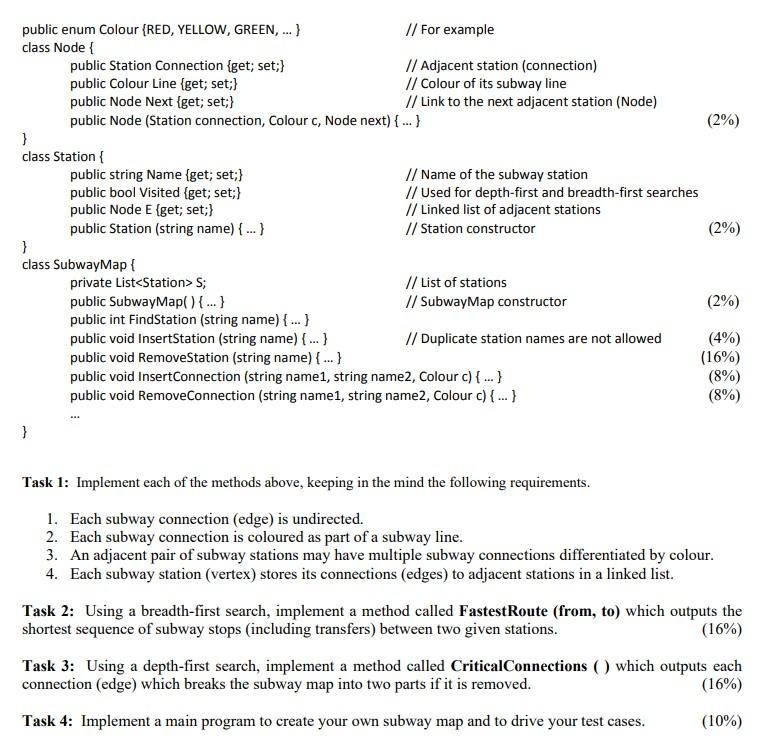Please use C# to solve this
needs to create a subway map

public enum Colour (RED, YELLOW, GREEN, ... } // For example class Node { public station Connection {get; set;} // Adjacent station (connection) public Colour Line {get; set;} // Colour of its subway line public Node Next {get; set;} // Link to the next adjacent station (Node) public Node (Station connection, Colour c, Node next) { ... } (2%) } class Station public string Name {get; set;} // Name of the subway station public bool visited {get; set;} // Used for depth-first and breadth-first searches public Node E {get; set;} // Linked list of adjacent stations public station (string name) {...} // Station constructor (2%) } class Subway Map { private List
S; // List of stations public Subway Map() {...} // Subway Map constructor (2%) public int FindStation (string name) {...} public void Insert Station (string name) {...} // Duplicate station names are not allowed (4%) public void RemoveStation (string name) {...} (16%) public void InsertConnection (string name1, string name2, Colour c) {...} (8%) public void RemoveConnection (string name1, string name2, Colour c) {...} (8%) 3. } Task 1: Implement each of the methods above, keeping in the mind the following requirements. 1. Each subway connection (edge) is undirected. 2. Each subway connection is coloured as part of a subway line. 3. An adjacent pair of subway stations may have multiple subway connections differentiated by colour. 4. Each subway station (vertex) stores its connections (edges) to adjacent stations in a linked list. Task 2: Using a breadth-first search, implement a method called FastestRoute (from, to) which outputs the shortest sequence of subway stops (including transfers) between two given stations. (16%) Task 3: Using a depth-first search, implement a method called CriticalConnections () which outputs each connection (edge) which breaks the subway map into two parts if it is removed. (16%) Task 4: Implement a main program to create your own subway map and to drive your test cases. (10%) public enum Colour (RED, YELLOW, GREEN, ... } // For example class Node { public station Connection {get; set;} // Adjacent station (connection) public Colour Line {get; set;} // Colour of its subway line public Node Next {get; set;} // Link to the next adjacent station (Node) public Node (Station connection, Colour c, Node next) { ... } (2%) } class Station public string Name {get; set;} // Name of the subway station public bool visited {get; set;} // Used for depth-first and breadth-first searches public Node E {get; set;} // Linked list of adjacent stations public station (string name) {...} // Station constructor (2%) } class Subway Map { private List S; // List of stations public Subway Map() {...} // Subway Map constructor (2%) public int FindStation (string name) {...} public void Insert Station (string name) {...} // Duplicate station names are not allowed (4%) public void RemoveStation (string name) {...} (16%) public void InsertConnection (string name1, string name2, Colour c) {...} (8%) public void RemoveConnection (string name1, string name2, Colour c) {...} (8%) 3. } Task 1: Implement each of the methods above, keeping in the mind the following requirements. 1. Each subway connection (edge) is undirected. 2. Each subway connection is coloured as part of a subway line. 3. An adjacent pair of subway stations may have multiple subway connections differentiated by colour. 4. Each subway station (vertex) stores its connections (edges) to adjacent stations in a linked list. Task 2: Using a breadth-first search, implement a method called FastestRoute (from, to) which outputs the shortest sequence of subway stops (including transfers) between two given stations. (16%) Task 3: Using a depth-first search, implement a method called CriticalConnections () which outputs each connection (edge) which breaks the subway map into two parts if it is removed. (16%) Task 4: Implement a main program to create your own subway map and to drive your test cases. (10%)







